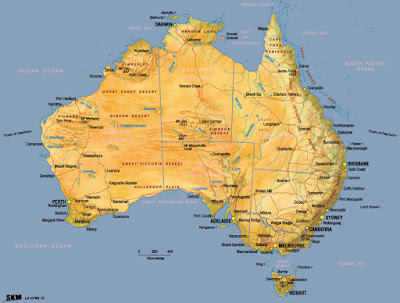 |
| Australia Island |
Australia’s stable political system, well-maintained roads, low crime rate and high standard of health care make it a safe and relatively easy country to explore
However, it's important to be aware of potential environmental hazards, such as bushfires, rough surf and extreme desert heat. You'll need to be thoroughly prepared for outback journeys and long bushwalks or hikes, and take sensible precautions in regards to sharks, crocodiles and poisonous animals. With the following common-sense tips, you can safely enjoy Australia's unique landscapes - from the vast outback to wild ocean beaches and pristine wilderness tracts.
Personal Security
Australia has a stable political system and low crime rate on a world scale and so Australians experience a safe lifestyle. It is generally a safe destination with tourists enjoying unhindered travel experiences in terms of their personal safety and security. However, as with all travel at home or away, you should observe the same precautions with your personal safety and possessions.
Sun protection
The Australian sun is very strong. Always wear a shirt, hat, sunglasses and SPF 30+ sunscreen lotion, even on cloudy days. If spending the whole day outdoors, reapply sunscreen regularly. Stay out of the sun during the middle of the day when the sun is strongest. Make sure you drink plenty of fluids to avoid dehydration.
Bushfires – fires in general
Australians live with the risk of bushfires. The danger period is from late spring to summer and during this time observe some simple safety precautions. Before setting out on a journey, inform yourself of bushfire risks through TV, radio and newspapers reports. When camping, use designated fireplaces and comply with road warning signs and total fire bans. If you must light a fire, always extinguish it completely with water.
Australia BushFire Fron Wiki : Wikipedia
Swimming between the flags
Australia’s beautiful beaches can hold hidden dangers in the form of strong currents called rips. Avoid them by always swimming between the red and yellow flags - they mark the safest place to swim on the beach. Lifesavers wearing red and yellow uniforms generally patrol beaches during the warmer months of October to April, but some of the most popular beaches are patrolled all-year round. Never swim alone, at night, under the influence of alcohol or directly after a meal. Always check water depth before diving in and never run and dive into the water from the beach.
Sharks and crocodiles
Shark attacks in Australia are very rare, however may be fatal. Shark netting on Australian beaches deter sharks, but you can further reduce your risk by always swimming between the flags on patrolled beaches and not swimming at dusk or evening. Avoid swimming alone, a long way offshore, at river mouths or along drop-offs to deeper water.
Crocodiles live in rivers and coastal estuaries across northern Australia, often changing habitat via sea. When travelling near crocodile habitats, observe safety signs and don’t swim in rivers, estuaries, tidal rivers, deep pools or mangrove shores. Also seek expert advice about crocodiles before camping, fishing or boating.
The poisonous animals – snakes, spiders, marine stingers
Marine stingers are present in tropical waters from November to April. During this time you can only swim within stinger-resistant enclosures, which are set up on the most popular beaches. You will also need to wear protective clothing when swimming,snorkeling or diving on the outer Great Barrier Reef. Always observe warning signs.
When bushwalking or hiking, you can avoid snake and spider bites by wearing protective footwear and using your common sense. If bitten, seek immediate medical attention. Deaths from snake bites are extremely rare and there have been few deaths from spider bites since anti venoms were made available in 1981.
Travelling in remote Australia
Driving through Australia’s remote and rugged areas requires thorough preparation. Before embarking on a 4WD or outback journey, ensure you have a roadworthy vehicle fitted with GPS and two spare tyres. You’ll also need good maps, extra food, water and fuel and an emergency plan. Plan your route carefully and notify a third party of your expected arrival. Check road conditions before beginning your journey, stay with your vehicle if it breaks down and avoid travelling in extreme heat conditions. If driving a conventional vehicle through remote areas, drive slowly on unsealed, dusty or narrow roads and always check road conditions before turning off major roads. Mobile phones have limited coverage in remote areas, so check your phone provider for coverage.
Bushwalking or hiking in wilderness
When planning a bushwalk or hike, check the length and difficulty of the walk and consider using a local guide for long or challenging walks. If walking without a guide, tell someone where you’re going and when you expect to return. Wear protective footwear, a hat, sunscreen and insect repellent and take wet weather gear, a topographic map and plenty of water. When walking, read maps and signs, stay on the track, behind safety barriers and away from cliff edges. Don’t feed or play with native animals, as you might get scratched or bitten. Plan walking in summer months carefully and avoid challenging hikes when the sun is too intense.
Visit Australia Site to get more TipsIn Here : Australia














